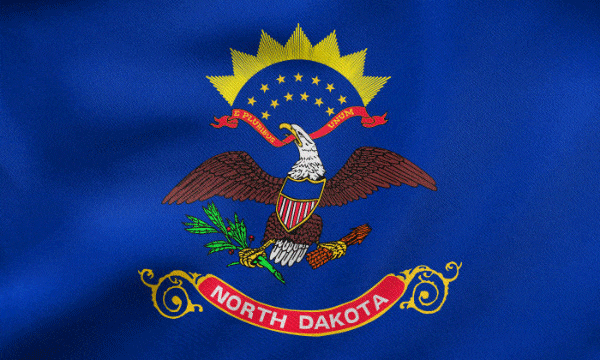North Dakota
State abbreviation/Postal code: N.D./ND Governor: Doug Burgum, R (to Dec. 15, 2020) Lieut. Governor: Brent Sanford, R (to Dec. 15, 2020) Senators:John Hoeven, R (to Jan. 2023); Heidi Heitkamp, D (to Jan. 2019) Historical biographies of Congressional members Organized as territory: March 2, 1861 Entered Union (rank): Nov. 2, 1889 (39) Present constitution adopted: 1889 Motto: Liberty and union, now and forever: one and inseparable
Nickname: Sioux State; Flickertail State; Peace Garden State; Rough Rider State Origin of name: From the Sioux tribe, meaning “allies” 10 largest cities (2012 est.): Fargo, 109,779; Bismarck, 64,751; Grand Forks, 53,456; Minot , 43,746; West Fargo, 27,478; Dickinson, 19,697; Mandan , 18,978; Williston, 18,532; Jamestown, 15,323; Wahpeton, 7,800 Land area: 70,698 sq mi (183,108 km2) Geographic center: In Sheridan Co., 5 mi. SW of McClusky Number of counties: 53 Largest county by population and area: Cass, 149,778 (2010); McKenzie, 2,742 sq mi. State parks: 17 Residents: North Dakotan 2016 resident population est.: 757,952 2010 resident census population (rank): 672,591 (49). Male: 339,864 (50.5%); Female: 332,727 (549.5%). White: 605,449 (90.0%); Black: 7,960 (1.2%); American Indian: 36,591 (5.4%); Asian: 6,909 (1.0%); Other race: 3,509 (0.5%); Two or more races: 11,853(1.8%); Hispanic/Latino: 13,467 (2.0%). 2010 percent population 18 and over: 77.7; 65 and over:14.5; median age: 37.0. |
North Dakota was explored in 1738–1740 by French Canadians led by Sieur de la Verendrye. In 1803, the U.S. acquired most of North Dakota from France in the Louisiana Purchase. Lewis and Clark explored the region in 1804–1806, and the first settlements were made at Pembina in 1812 by Scottish and Irish families while this area was still in dispute between the U.S. and Great Britain. In 1818, the U.S. obtained the northeast part of North Dakota by treaty with Great Britain and took possession of Pembina in 1823. However, the region remained largely unsettled until the construction of the railroad in the 1870s and 1880s.
North Dakota is the most rural of all the states, with farms covering more than 90% of the land. North Dakota ranks first in the nation's production of spring and durum wheat; other agricultural products include barley, rye, sunflowers, dry edible beans, honey, oats, flaxseed, sugar beets, hay, beef cattle, sheep, and hogs.
Recently, manufacturing industries have grown, especially food processing and farm equipment. The state's coal and oil reserves are plentiful, and it also produces natural gas, lignite, clay, sand, and gravel.
The Garrison Dam on the Missouri River provides extensive irrigation and produces 400,000 kilowatts of electricity for the Missouri Basin areas.
Known for its waterfowl, grouse, pheasant, and deer hunting and bass, trout, and pike fishing, North Dakota has 20 state parks and recreation areas. Points of interest include the International Peace Garden near Dunseith, Fort Union Trading Post National Historic Site near Williston, Knife River Indian Villages National Historic Site in Stanton, the State Capitol at Bismarck, the Badlands, Theodore Roosevelt National Park, and Fort Abraham Lincoln State Park.
See more on North Dakota:
Encyclopedia: North Dakota
Encyclopedia: Geography
Encyclopedia: Economy
Encyclopedia: Government
Encyclopedia: History
Monthly Temperature Extremes
All U.S. States: Geography & Climate
Printable Outline Maps
Record Highest Temperatures
Record Lowest Temperatures
Highest, Lowest, and Mean Elevations
Land and Water Area
All U.S. States: Population & Economy
Historical Population Statistics, 1790–Present
Per Capita Personal Income
Minimum Wage Rates
State Taxes
Federal Government Expenditure
Percent of People in Poverty
Births and Birth Rates
Homeownership
Percentage of Uninsured by State
All U.S. States: Society & Culture:
Most Livable States
Healthiest States
Most Dangerous States
Smartest States
Crime Index
Residency Requirements for Voting
Compulsory School Attendance Laws
Driving Laws
National Public Radio Stations
Selected famous natives and residents:
- Lynn Anderson singer;
- Maxwell Anderson playwright;
- Dr. Robert H. Bahmer U.S. archivist;
- Elizabeth Bodine humanitarian;
- Dr. Anne Carlsen educator;
- Warren Christopher statesman;
- Ronald N. Davies jurist;
- Angie Dickinson actress;
- Ivan Dmitre artist;
- Carl Ben Eielson aviator;
- Phyllis Frelich actress;
- Bertin C. Gamble founder of Gamble-Skogmo;
- William H. Gass writer and philosopher;
- Rev. Richard C. Halverson U.S. Senate chaplain;
- Brynhild Haugland state legislator;
- Phil D. Jackson basketball player and coach;
- Dr. Leon O. Jacobson researcher and educator;
- Harold K. Johnson general;
- David C. Jones general;
- Louis L'Amour author;
- Peggy Lee singer;
- William Lemke representative;
- Roger Maris baseball player;
- Marquis de Mores cattleman who established Medora;
- Gerald P. Nye senator;
- Casper Oimoen skier;
- William A. Owens admiral;
- Arthur Peterson radio and TV actor;
- Cliff (Fido) Purpur hockey player and coach;
- James Rosenquist painter;
- Harold Schafer founder of Gold Seal Co.;
- Eric Sevareid TV commentator;
- Ann Sothern actress;
- Dorothy Stickney actress;
- Edward K. Thompson Life magazine editor;
- Era Bell Thompson Ebony magazine editor;
- Tommy Tucker band leader;
- Bobby Vee entertainer;
- Lawrence Welk band leader;
- Larry Woiwode writer.


